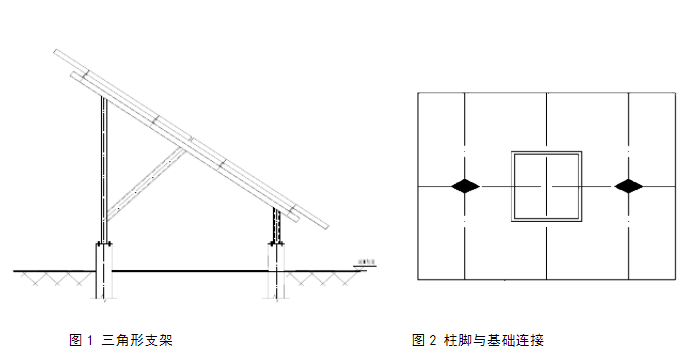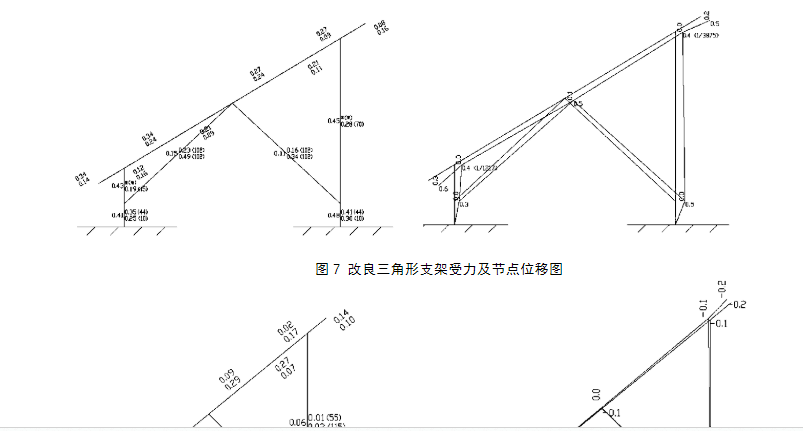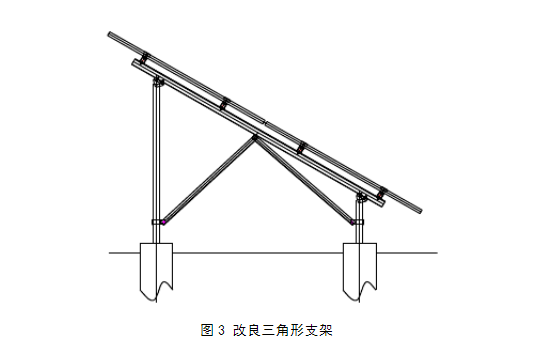Abstract: Solar mounting system is an important part in fixing thesolar panels. An appropriate form has great significance in controlling the engineering cost of photovoltaic plant. This paper introduced the common bracket types and support forms that used in photovoltaic power station, showedthe characteristics of all kinds of support forms, and then analyzed theirsteel consumption, stress and displacement. The result provide a reference for the support solar mounting structure designof photovoltaic power station。
With the development of modern industry, the energy crisis and air pollution problems have become increasingly prominent, and solar energy has become the focus of attention with its unique advantages. China's solar photovoltaic industry has also developed rapidly, becoming one of the most widely used new energy sources. Solar panel bracket is an important part of photovoltaic power station. The choice of bracket will directly affect the operation safety, damage rate and construction investment of PV modules. Under the premise of ensuring the normal operation of PV modules, reducing the amount of steel used in each group of brackets has become The focus and difficulty of photovoltaic power generation projects. Choosing the right bracket not only reduces the project cost, but also reduces the cost of maintenance. Therefore, the research on the selection of solar mounting systems is of great significance.
First, the classification and characteristics of the bracket.
A photovoltaic cell is a basic unit that directly converts the solar light energy into electrical energy. The battery is combined to form a battery component, which is a basic power generation device of a photovoltaic power plant. In combination with the current industrial status and capacity of the domestic solar cell market, commercial solar cells are mainly of the following types: monocrystalline silicon solar cells, polycrystalline silicon thin film solar cells, amorphous silicon thin film solar cells, copper indium gallium selenide thin film solar cells (CIGS) )
The crystalline silicon battery module is mostly equipped with a stainless steel frame, which can be well adapted to the deformation of the bracket through the frame of the component, and the damage rate is low. The film-like battery components are mostly frameless, and the deformation of the bracket is poorly adapted, and the component damage rate can reach 3 ~5‰, taking 30MW photovoltaic power station as an example, the investment of replacing only damaged components can reach 60~-1 million yuan per year after completion. Therefore, in the photovoltaic power plant using the thin film battery assembly, special attention should be paid to the deformation of the bracket.
At present, the solar mounting system systems commonly used in China are mainly composed of three types: concrete supports, aluminum alloy supports and steel supports. The mixed soil bracket is mainly used in large-scale photovoltaic power stations. It is self-contained and has high stability and can support large-sized photovoltaic panels, such as single-axis photovoltaic systems. However, the construction is slow, the construction period is long, and the assembly degree is low, which is less used in the common fixed-station photovoltaic power station. Aluminum alloy brackets are generally used in the roof of civil buildings, which are corrosion-resistant, light in weight, beautiful and durable, but have low bearing capacity and high price, and are used less in domestic ground power stations. The steel bracket has stable performance, mature manufacturing process, high bearing capacity and easy installation. The cold-formed thin-walled steel widely used in the bracket is factory-produced, with uniform specifications, stable performance, excellent anti-corrosion performance and beautiful appearance. Due to its high strength, light weight and good stability, steel structures are widely used in civil and industrial solar photovoltaic and solar power plants. At the same time, "Photovoltaic Power Generation Design Code" GB50797-2012 indicates that the material of the solar mounting bracket should be steel. The selection of materials and the design of the bracket should comply with the current national standard "Code for Design of Steel Structures" GB50017-2003. Therefore, this paper focuses on Steel structural support in ground photovoltaics.
Second, the common steel bracket structure type
2.1 triangle bracket
This type of bracket is a form of brackets used in early photovoltaic projects. Figure 1 shows the brackets with long and short legs. The legs are bolted to the foundation. One end of the diagonal support is supported on the long column and the end is in the middle of the slope. The stringer is supported on the sloping sill to form a solar panel support system. The structure is a geometrically invariant system with no extra constraints.
The connection between the foot of the solar mounting system column and the foundation commonly used in such a bracket structure is shown in Fig. 2. This type of structure is a frameless battery assembly which is deformed by a large amount of steel if the column foot is hinged, and the deformation of the bracket is high. The breakage rate is very high.

2.2 modified triangle bracket
The triangular bracket requires a relatively loose connection between the leg and the foundation. In order to effectively solve this problem, after an in-depth study, the improved tripod is born (Fig. 3), the bracket adds an oblique support to the triangular bracket. The overall stability of the bracket is increased, the amount of steel is slightly increased, the front and rear pillars are cooperatively deformed, and the deformation is reduced, which is suitable for various forms of photovoltaic module brackets, especially large wind loads, uneven geothermal fluctuations or mountain photovoltaics. , a project that requires high integrity and deformation of the bracket.
2.3 herringbone bracket
The herringbone bracket follows the "three rigid piece rule" in structural mechanics: that is, the three rigid pieces are invariant with a set system of three single hinges and two pairs that are not in a straight line, and there is no unnecessary constraint. It is also a simple binary type bracket (Fig. 4). Because the long and short legs are removed, the amount of steel used is small, the bracket form is simpler, and the construction and installation are more convenient. However, this type of bracket also has certain limitations: 1) because it can not adjust the bracket in the height direction, this bracket is only suitable for terrain with less flat and undulating terrain; 2) because the bracket removes the length and length of the leg, the crossover cantilever When the length is lengthened and the upper load is increased, the degree of bracket generation will also increase. This will cause hidden dangers to the stability of the solar mounting system system and the breakage rate of the frameless photovoltaic module. Therefore, the herringbone bracket is only used for projects with less wind load. surroundings.

2.4 improved herringbone bracket
In order to effectively solve the characteristics of the square bracket with the large amount of steel for the herringbone bracket, a modified version of the herringbone frame (Fig. 5) is formed. The bracket form is added to the rear leg on the basis of the herringbone bracket. Therefore, the length of the cantilever of the transverse raft is reduced, and the stability of the support system is enhanced, and the damage rate of the photovoltaic module is reduced. The amount of steel used to improve the herringbone bracket is only slightly larger than that of the herringbone bracket, but the amount of steel used is reduced compared to the two triangular brackets.
2.5 single column solar mounts
The single-column solar mounting system structure is mainly composed of key components such as main beam, secondary sill, front support, rear support, steel column, hoop and single pile foundation. As shown in Fig. 6, the single-column solar mounting bracket structure uses two oblique supports. Supporting the primary and secondary beams to support the photovoltaic panels, the steel diagonal bracing and the single-column foundation are connected by hoops, which are simple and effective. At the same time, the single-column solar mounting structure occupies less space, and can fully utilize the front and rear support of the single-column solar mounts structure between the front and rear photovoltaic strings, which is an elongated version of the front and rear support of the double-column solar structure, and The single-column solar mounting structure increases the hoop, steel column and other components, so the steel consumption of the single-column support structure is significantly improved compared with the double-column solar mounting system.
Third, the bracket force and deformation analysis
For example, Qinghai Engineering, because the project uses thin-film photovoltaic modules, the terrain is relatively flat, considering the applicability of the bracket to analyze the force and deformation of the modified triangular bracket and the improved herringbone bracket, the known design parameters are: The angle of inclination is 34 degrees, the external environment is the beach, the terrain is flat, the wind load is 0.42kNm2 in 30 years, the seismic fortification intensity is 7 degrees, the basic seismic acceleration value is 010g, and the design characteristic period value is 0.45s. The site category is Class II, and the lowest point of the photovoltaic panel is 0.5m from the ground. The internal force of the structure and the displacement of the joint are shown in Fig. 7 to Fig. 8.

It can be seen that the modified triangular bracket has a slightly larger internal force and node displacement than the modified herringbone technical support. The improved herringbone bracket is much less powerful than the modified triangular bracket, so the structural strength, steel volume and joint displacement of the modified herringbone bracket are the minimum, which is the optimal solution for this project.
4 Conclusion
This paper introduces the commonly used forms of solar mounting bracket in China, analyzes the characteristics of various types of supports, and draws the following conclusions in combination with an engineering design in Qinghai:
1) At present, the type of solar panel bracket is mainly steel structure, and the design of photovoltaic power generation also stipulates the design of this form.
2) Through the analysis of the characteristics of various solar mounting systems, it can be seen that the triangular brackets have higher requirements for the connection of the columns; the herringbone bracket is the most economical form of steel, but there are limitations on the suitability of the site, components and foundation; The herringbone bracket has a slight increase in the amount of steel used.
However, the stability has been greatly improved, but the engineering site and foundation are also required to be higher; the single-column photovoltaic bracket has the smallest footprint and the largest amount of steel.
3) The internal force and node displacement of the modified herringbone bracket are relatively small, and the solar mounting structure is relatively stable. The forms of various types of photovoltaic brackets have their advantages and disadvantages. The design should be rationally selected according to the location and application environment of the project, and comprehensive consideration of various factors to select the optimal solution.
(This article is from Hebei Electric Power Survey and Design Institute, Shijiazhuang 050031, China, Li Na & Criminal Ke Yong)




